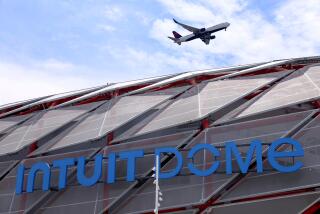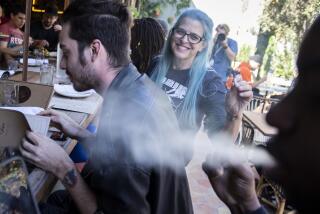Getting All Choked Up
- Share via
California’s new law banning smoking in bars was supposed to be the death knell for thousands of the state’s mom-and-pop-owned watering holes, or so the doomsayers predicted.
But two weeks into the new year, the biggest losers are a host of large companies with household names. They include upscale bars, restaurants and hotels, many of which catered to cigar-smoking customers.
While many of their smaller and lesser-known counterparts look the other way, these companies are complying with the law, and it’s starting to hurt.
At Morton’s of Chicago in Costa Mesa, receipts in the bar--where customers were encouraged to enjoy a big cigar after devouring a big steak--are running 10% to 15% below last year’s level. “We are concerned because it’s an area where we generate a lot of profit,” said J.C. Clow, general manager.
At the Ritz-Carlton Laguna Niguel, the resort’s library, which became a smoking room after dark, is again reserved solely for the literary minded. Before the new law took effect, a dozen or more guests would drop by on a given evening for cognac or scotch (about $10 a glass) and a stogie (anywhere from $10 to $30.) The library crowd has thinned considerably.
Bar receipts at the Balboa Bay Club in Newport Beach also are lagging, but the club is trying to keep its smoking members happy by erecting a tent for them on a deck outside its lounge.
Each of these businesses is trying to cope with the final phase of the California Smoke-free Workplace Act of 1994, which is designed to protect workers from the harmful effects of secondhand smoke. Beginning Jan. 1, it banned smoking in bars, pool halls and bingo parlors--the last places that allowed indoor puffing. It requires bar owners to post no-smoking signs, remove all ashtrays and inform patrons they can’t smoke.
Of biggest concern to the region’s more than 5,200 bars and restaurants that sell alcohol are people like Jim Addis, who smokes about eight cigars a month.
Addis, co-owner of an El Monte metal-finishing company, said the new law “will most definitely” reduce the number of cigars he will smoke and, subsequently, pare the number of drinks and meals he consumes away from his Newport Beach home.
On Sunday, Addis and a smaller-than-usual crowd gathered at the Balboa club, a private bay front establishment, to watch the NFC championship game.
In a sun-drenched tent at water’s edge, a dozen club members puffed and drank as the Packers trounced the 49ers. Inside the club’s lounge--and a lot closer to the bar--more than 20 patrons ate, drank and watched the game.
Many smaller, independently owned bars are exempt from the new law because they employ fewer than five people.
Others, such as Erwin Held, owner of Barney’s Beanery in West Hollywood, simply are not living up to the spirit of the law.
“All the law requires us to do is post no-smoking signs, remove ashtrays and ask people not to smoke,” Held said. “When they do smoke, we’re not throwing them out, and we’re not refusing them service.”
He is encouraging smoking customers to bring their own ashtrays, however.
The new law isn’t having a dramatic effect at the more moderate-priced restaurant chains, such as TGI Friday’s, El Torito and Claim Jumper, all of which allowed smoking in their bars. Many of the chains’ restaurants have patio areas, where smokers can inhale and exhale at will.
Irvine-based Claim Jumper, which has 19 eateries in California, plans to convert the bars in some of its restaurants to dining areas.
The new law “hasn’t been much of an issue, and I think it’s because there has been so much information in print and on the news,” said Larry Bill, a company spokesman. “We’ve had a lot of regular customers tell us that this was an excuse to start on the patch, or some other [stop-smoking] program.”
*
Studies conducted by the state health department found that only 15% of the adults in California smoke on a regular basis. However, those folks also tend to drink, and doing the two together is a favorite pastime, especially during football season.
That’s particularly vexing for restaurants that operate bars, which generate roughly 20% to 25% of a restaurant’s revenue.
“A bar is less labor intensive, and less intensive from a product-cost standpoint,” said Randall Hiatt, president of Fessel International, an Irvine restaurant consultant.
As a result, profit margins generated by bars tend to run in the 25% to 30% range, double the 12% to 15% profit margins of the restaurant business, Hiatt said. That translates into a lot of money for Southland bars and restaurants, which racked up sales of $4.5 billion in 1996, the latest figures available from the state Board of Equalization.
Besides lost revenue, the new law has meant added expense for some businesses. The Balboa Bay Club spent about $8,000 to erect its smoking tent, said general manager Henry Schielein. And the Ritz-Carlton printed up special notices in several European and Asian languages to explain to guests that they can no longer smoke inside the resort, said Suzanne Willis, the hotel’s spokeswoman.
For business owners, violations come with a $100 fine for first-time offenders, a $200 fine for a second violation and a $500 fine for a third. Subsequent violations are handled by the state Occupational Safety & Health Administration, which can dole out penalties as high as $7,000 per violation.
The law, which bans smoking in any indoor workplace area, exempts specialty shops that receive their main source of income from tobacco sales.
In the first nine days of the year, Orange County’s Tobacco Use Prevention Program hotline received about 350 calls, two-thirds of them seeking more information about the new law.
About 100 callers phoned to complain about alleged violations.


